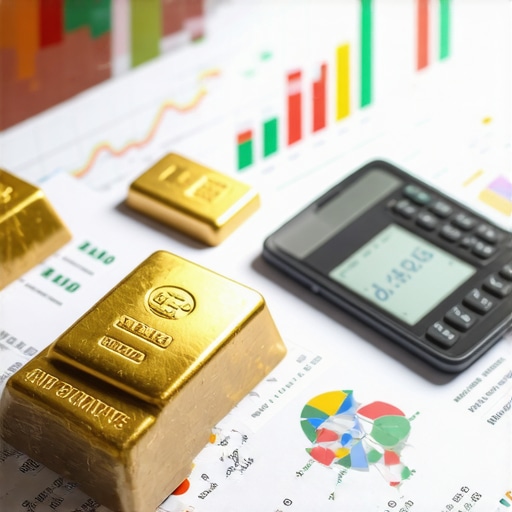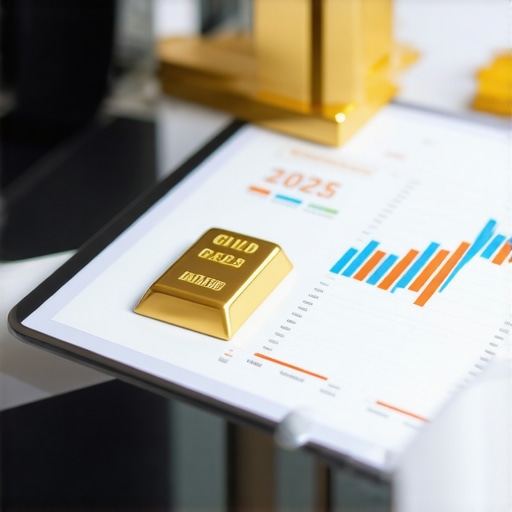How I Discovered the Power of Gold ETFs for Long-Term Growth
When I first dipped my toes into investing, the idea of owning physical gold always seemed appealing but somewhat daunting. The storage, the security concerns, and the liquidity issues made me hesitant. That’s when I stumbled upon gold ETFs (Exchange Traded Funds) — a way to gain exposure to gold without the hassles of physical ownership. Over the years, investing in gold ETFs became a cornerstone of my portfolio for long-term growth and wealth preservation.
Why Gold ETFs Became My Go-To for Diversification
One of the biggest lessons I learned early on is the importance of diversification. Gold ETFs offer a unique advantage by allowing investors to own gold in a liquid, easy-to-trade format. Unlike physical gold, I don’t have to worry about safekeeping or authenticity issues. Plus, their accessibility through regular brokerage accounts makes them incredibly convenient.
From my experience, gold ETFs can act as a hedge against inflation and market volatility, especially during economic uncertainty. If you’re curious about how to navigate these uncertain times effectively, I found this guide on effective gold investment strategies during economic uncertainty to be a helpful resource.
What Should You Look for When Choosing Gold ETFs for Long-Term Growth?
When I started comparing different gold ETFs, I realized there are several factors that can make a difference in performance and suitability for long-term investing. Here are some key aspects I always check:
- Expense Ratios: Lower fees mean more of your money stays invested. I prefer ETFs with minimal expense ratios.
- Tracking Accuracy: The best gold ETFs closely track the spot price of gold with minimal tracking error.
- Liquidity: High trading volumes ensure tight bid-ask spreads and easier buying or selling.
- Fund Size and Reputation: Larger, well-established ETFs tend to be more stable and reliable.
One ETF I’ve personally favored is the SPDR Gold Shares (GLD), which has consistently demonstrated strong liquidity and tracking precision.
How I Balanced Gold ETFs with Other Gold Investments
While gold ETFs offer excellent benefits, I didn’t want to put all my eggs in one basket. I supplemented my gold ETF holdings with a mix of physical gold and gold mining stocks. This blend helped me capture different angles of gold’s growth potential—whether it’s price appreciation, dividend income, or capitalizing on mining company performance.
If you want a deeper dive into combining gold ETFs with physical gold, this article comparing gold ETFs and physical gold helped me understand the pros and cons of each approach.
My Takeaway: Why Patience and Research Matter Most
Patience is crucial when investing in gold ETFs for long-term growth. The gold market can be volatile, and short-term price swings are common. But by focusing on quality ETFs and staying committed, I’ve seen my investments serve as a steady anchor in my portfolio through various market cycles.
For anyone considering this path, I encourage you to research thoroughly and stay updated on market trends. Trusted sources like the World Gold Council’s research hub provide invaluable data on gold demand and supply dynamics that can influence ETF performance.
If you’ve had experiences with gold ETFs or are thinking about starting, I’d love to hear your thoughts and questions. Feel free to share your journey or ask anything in the comments below!
Optimizing Gold ETF Holdings with Tactical Asset Allocation
Beyond simply holding gold ETFs, I’ve found that tactical asset allocation within the gold segment can enhance long-term returns. This means adjusting your gold ETF allocation based on macroeconomic signals like inflation trends, real interest rates, and geopolitical risks. For instance, when inflation expectations rise, increasing gold ETF exposure can protect purchasing power, while during stable economic periods, reducing allocations to gold ETFs in favor of growth assets may be prudent.
Such dynamic management requires staying updated with economic indicators and gold market fundamentals. Tools like the gold supply and demand analysis provide essential insights to anticipate market movements that affect gold prices and ETF performance.
How Do Global Central Bank Gold Purchases Influence Gold ETF Performance?
Central banks around the world have increasingly become significant players in the gold market. Their purchase patterns can directly impact gold supply, prices, and thus the performance of gold ETFs. When central banks increase their gold reserves, it signals confidence in gold as a store of value, often leading to price appreciation.
Conversely, if central banks reduce holdings or delay purchases, it may temper price momentum. Keeping an eye on these trends, as explained in detailed analyses like this expert review of central bank gold purchases, can provide an edge for ETF investors aiming to time their allocations more effectively.
Leveraging Gold ETFs in Retirement Accounts for Tax Advantages
Another strategic layer I’ve integrated is holding gold ETFs within tax-advantaged retirement accounts such as IRAs. Gold ETFs that meet IRS criteria can be included in self-directed IRAs, offering the dual benefits of gold’s portfolio diversification and tax-deferred growth.
For investors focused on securing retirement wealth, understanding the nuances of these accounts is critical. Resources like best gold IRA strategies for secure retirement wealth outline how to select ETFs approved for IRAs and optimize contributions to maximize long-term benefits.
By combining tactical gold ETF investing with retirement account advantages, I’ve built a resilient portfolio that aligns with my long-term financial goals.
Risks and Considerations: What Experienced Investors Should Watch For
While gold ETFs are a convenient way to invest in gold, seasoned investors must be mindful of risks such as market volatility, ETF liquidity during extreme stress, and the impact of management fees over time. Additionally, regulatory changes affecting ETF structures or tax treatment can influence returns.
Staying informed through authoritative sources, including the World Gold Council’s research hub, helps me anticipate and navigate these challenges. Also, diversifying within different gold investment vehicles can mitigate some risks inherent to ETFs alone.
If you’re exploring ways to deepen your gold investment knowledge, I encourage you to read about starting gold trading to understand market mechanics more comprehensively.
Have you tried combining gold ETFs with other gold investment forms? Share your strategies or questions below—let’s build a knowledgeable community focused on smart gold investing!
Reflecting on the Subtle Dynamics of Gold ETF Performance
Over the years, I’ve come to appreciate that gold ETFs, while straightforward on the surface, have layers of complexity that can significantly impact long-term growth. One subtlety that often gets overlooked is how the structure of the ETF itself can influence returns. For example, some ETFs physically hold gold bullion, while others use derivatives or futures contracts to replicate gold exposure. This distinction isn’t just academic; it affects tracking accuracy, counterparty risk, and even tax treatment.
Understanding these nuances helped me refine my ETF selections beyond just expense ratios or liquidity. It’s worth diving deep into the fund’s prospectus and operational details. For those interested, exploring the best gold ETFs for portfolio diversification in 2027 provided me with updated insights into which funds align well with long-term strategies.
How Should Investors Weigh the Impact of Gold Lease Rates and ETF Gold Holdings?
This question challenged me when I stumbled upon discussions about gold lease rates and their indirect effect on gold ETFs. Gold lease rates represent the interest charged for borrowing physical gold, which influences the cost dynamics of gold lending and can cause subtle price pressures. While ETFs typically hold allocated gold, the broader gold market’s leasing activity can ripple into ETF pricing and premiums.
It’s fascinating how such seemingly technical factors matter when holding gold ETFs over the long haul. I found that staying informed about these market mechanisms, alongside fundamental supply and demand trends, helped me anticipate periods when ETFs might trade at premiums or discounts relative to their net asset value. The gold supply and demand analysis I regularly consult offers a comprehensive view that ties these threads together.
Personal Experience: Managing Gold ETF Volatility Without Losing Sight of the Horizon
One of the most challenging aspects I’ve faced is managing my emotional response to short-term volatility in gold ETFs. Although gold is often touted as a safe haven, its price can be surprisingly reactive to geopolitical developments, currency fluctuations, and shifts in real interest rates.
In one notable episode, during a sudden global economic scare, gold ETFs spiked sharply, prompting a dilemma: should I capitalize on gains or hold firm? My decision to stay the course was rooted in trust in gold’s long-term value proposition rather than chasing quick profits. This experience underscored the importance of aligning investment decisions with personal risk tolerance and time horizon.
For those navigating similar volatility, I encourage exploring strategies detailed in resources like effective gold investment strategies during economic uncertainty to maintain perspective and discipline.
Exploring Tax Implications Beyond Retirement Accounts
While I’ve shared how holding gold ETFs in IRAs can be advantageous, understanding tax implications outside retirement accounts is equally crucial. Different jurisdictions treat gains on gold ETFs variably—some categorize them as collectibles with higher capital gains tax rates; others may treat them like stocks.
I’ve learned that consulting a tax professional and reviewing authoritative materials ensures I optimize my holdings and plan distributions wisely. This awareness shapes decisions on when to sell or rebalance holdings, especially in taxable accounts.
Are There Emerging Gold ETF Innovations Worth Watching?
Innovation in the ETF space continues to evolve, and some newer gold ETFs are experimenting with enhanced features like fractional ownership, lower fees, or integration with blockchain technology for transparency. While I cautiously monitor these developments, I remain focused on how these innovations might improve liquidity, reduce costs, or offer novel ways to secure gold exposure.
For readers intrigued by these trends, I recommend keeping an eye on updates from fund managers and industry experts. Such developments could reshape how we think about gold investing in the near future.
If you have encountered unique gold ETF products or strategies, I’d be excited to hear about your experiences or questions. Sharing diverse perspectives enriches our collective understanding.
Unraveling the Intricacies of Gold ETF Custodianship and Its Impact on Investor Confidence
Throughout my journey with gold ETFs, one element that profoundly shaped my trust in certain funds was the identity and practices of the custodian holding the physical gold. Unlike straightforward stock ETFs, gold ETFs rely heavily on custodians to securely store and insure the bullion backing each share. This layer adds a dimension of operational risk that often goes unnoticed by casual investors.
I’ve learned that custodianship transparency and audit frequency are paramount. For example, funds like SPDR Gold Shares (GLD) publish regular reports verifying their gold holdings, which reassured me during periods of market turbulence. Conversely, ETFs lacking such transparency can introduce uncertainties about actual gold reserves versus shares outstanding, potentially impacting both tracking precision and investor confidence.
For those eager to delve deeper, this comprehensive overview of top gold ETFs in 2027 offers valuable insights into custodial arrangements and operational frameworks that differentiate leading funds.
How Do Variations in ETF Structures Influence Tax Efficiency and Long-Term Profitability?
This question challenged me to explore beyond surface-level metrics. Different gold ETFs adopt varying structures—some physically backed by allocated gold bullion, others employing futures or derivatives to simulate exposure. These structural differences can profoundly influence tax treatment. For instance, ETFs holding physical bullion may be taxed as collectibles in several jurisdictions, subjecting gains to higher capital gains rates, whereas derivative-based ETFs might be treated more like conventional securities.
Such distinctions affect not only after-tax returns but also portfolio rebalancing strategies. I discovered that aligning ETF structure with my tax circumstances was crucial to optimizing net growth, especially within taxable accounts. Engaging with expert tax resources and consulting financial advisors helped me navigate these complexities effectively.
Integrating Advanced Macro Indicators to Fine-Tune Gold ETF Allocation
Beyond fundamental supply-demand dynamics, I found that incorporating advanced macroeconomic indicators significantly sharpened my timing for gold ETF adjustments. Monitoring real interest rates, currency strength, and inflation expectations—especially through nuanced metrics like breakeven inflation rates and global monetary policy shifts—provided actionable signals.
I regularly reference gold supply and demand analyses to contextualize these macro signals within the physical market landscape. This holistic approach empowered me to anticipate gold price inflection points more confidently, enabling tactical portfolio moves that enhanced long-term growth while mitigating downside risks.
Embracing this level of market sophistication transformed my perspective from passive holding to proactive management, where timing and macro awareness become as vital as asset selection.
Expanding Horizons: Exploring Emerging Gold ETF Innovations and Their Implications
As the gold investment landscape evolves, I’ve been intrigued by innovative ETF products introducing fractional ownership models and blockchain-powered transparency features. These innovations promise lower entry barriers and enhanced auditability, potentially revolutionizing investor access and trust.
While cautiously optimistic, I’ve been tracking how these innovations might shift liquidity paradigms and fee structures. Integrating such cutting-edge products requires balancing innovation with proven stability, especially for long-term wealth preservation. Staying abreast of these developments by following fund managers’ communications and industry analyses is part of my ongoing commitment to informed investing.
If you’re fascinated by these frontier ETFs or have hands-on experience with them, please share your insights or queries. Building a dialogue helps all of us navigate this dynamic space more confidently and effectively.
Things I Wish I Knew Earlier (or You Might Find Surprising)
Gold ETFs Aren’t All Created Equal
When I first started investing in gold ETFs, I assumed they all functioned similarly. But I learned that the ETF’s underlying structure—whether it holds physical gold or uses derivatives—can profoundly affect your returns and risks. Diving into fund prospectuses and understanding these differences helped me avoid surprises and select ETFs that truly matched my long-term goals.
Custodian Transparency Can Make or Break Confidence
I used to overlook the importance of who holds the gold behind the ETF. Over time, I realized that ETFs with transparent custodianship and regular audits, like SPDR Gold Shares (GLD), give me peace of mind during market turbulence. This subtlety isn’t always obvious but matters a lot for trust and performance.
Tax Implications Vary Widely and Impact Net Gains
Understanding how different gold ETFs are taxed—especially in taxable accounts—was a game-changer. Some ETFs are treated as collectibles with higher capital gains tax, while others benefit from more favorable treatment. This insight shifted how I balanced my holdings between taxable brokerage accounts and IRAs to optimize after-tax returns.
Volatility Is Part of the Journey, Not a Signal to Panic
Gold ETFs can surprise you with sharp price swings, even though gold is often seen as a safe haven. Early on, I struggled emotionally during volatile periods, but learning to focus on the long-term horizon and fundamental macroeconomic trends helped me stay calm and avoid rash decisions.
Macro Indicators Enhance Tactical Allocation
Simply holding gold ETFs isn’t enough if you want to maximize growth. Over time, I integrated macroeconomic signals like real interest rates and inflation expectations into my allocation decisions. This proactive approach, supported by resources like gold supply and demand analysis, helped me fine-tune my portfolio with better timing and confidence.
Innovations in Gold ETFs Could Change the Game
Keeping an eye on emerging products offering fractional ownership and blockchain transparency opened my eyes to future possibilities. While I stay cautious, these innovations might lower barriers and boost liquidity for investors like us. It’s exciting to watch this space evolve and imagine how it could reshape gold investing.
Resources I’ve Come to Trust Over Time
World Gold Council’s Research Hub: This has been my go-to for reliable data on gold demand, supply, and market trends. Their research deepens my understanding and helps me anticipate shifts affecting gold ETFs. You can explore it here.
BuyingGoldNow.com Guides: The site offers practical, up-to-date articles like best gold ETFs for portfolio diversification in 2027 and best gold IRA strategies, which helped me make informed ETF selections and retirement planning decisions.
Central Bank Gold Purchase Analysis: Monitoring central bank buying trends via insightful breakdowns like this expert review gave me an edge in understanding supply pressures and price movements.
Tax and Trading Strategy Resources: For navigating tax nuances and gold trading basics, I’ve found this beginner’s guide invaluable for mastering market mechanics and avoiding pitfalls.
Parting Thoughts from My Perspective
Investing in gold ETFs for long-term growth has been a journey of discovery, patience, and continual learning. From the early days of simply wanting gold exposure without the headaches of physical storage to now actively managing allocations with macro insights, the experience has deepened my appreciation for gold’s role in a diversified portfolio.
Gold ETFs are not just a convenient vehicle; they reflect a complex ecosystem involving custodians, tax regimes, and global economic forces. Embracing this complexity rather than shying away from it empowered me to build a resilient, growth-oriented portfolio aligned with my financial goals.
If this resonated with you, I’d love to hear your thoughts or experiences with gold ETFs. Share your journey or questions in the comments below—let’s keep the conversation going and learn from each other’s insights.











This post really highlights how important it is to understand the nuances behind gold ETF investments. I personally started with physical gold but found it impractical due to storage concerns, so switching to ETFs was a game-changer for me, especially with their liquidity and ease of trading. I was particularly interested in the part about custodial transparency—knowing that GLD publishes regular audits gave me extra confidence in those holdings. One thing I’ve noticed in my experience is that small differences in expense ratios and tracking accuracy can have a significant impact over the long haul, so I always look for ETFs with solid track records and low fees. Has anyone else explored the newer gold ETFs that utilize blockchain technology for better transparency? I’d love to hear insights or experiences with those innovative funds as I consider diversifying further.